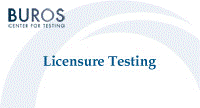Buros-Nebraska Series on Measurement and Testing
Date of this Version
1995
Document Type
Article
Citation
Licensure Testing: Purposes, Procedures, and Practices, ed. James C. Impara (Lincoln, NE: Buros Institute of Mental Measurements, University of Nebraska-Lincoln, 1995).
Abstract
In this chapter the author presents the legal setting for licensure testing, I discusses the role of various professional standards and codes (i.e., the EEOC Uniform Guidelines, 1978, and the AERA/APA/NCME Standards, 1985), presents some of the pertinent rulings from several court decisions, and makes inferences about future changes in professional standards and their potential impact on licensure test development.
There necessarily is some minor overlap with the material in this chapter and some other chapters in this book. There is a brief discussion of the differences between licensure, certification. and employment testing and how those differences relate to the professional standards and court cases. It is necessary to mention some concepts such as task analysis, validity, and cut scores when discussing the professional standards and the court cases. However, these concepts are not dealt with in the depth that occurs in later chapters.
THE LEGAL SETTING
Licensure and certification tests are high-stakes tests and those considering using or constructing such tests should be aware of previous case law regarding such testing. Some generic legal issues are discussed first. In subsequent sections, the various professional standards and some court decisions are presented.
Generic Legal Issues
Existing case law is based on constitutional requirements- primarily the 14th Amendment- and statutory requirements- primarily Title VII of the 1964 Civil Rights Act.
Constitutional Requirements: The 14th Amendment
Two basic requirements of the U.S. Constitution's 14th Amendment are discussed: equal protection and due process. For a plaintiff to win under the equal protection analysis, it must be shown that there was intent to discriminate. In Village of Arlington Heights v. Metropolitan Housing Development Corp. (1977) , the court stated that the following factors could be considered in establishing discriminatory intent: (a) historical background, (b) the specific sequence of events leading up to the challenged decision, (c) departures from normal procedural sequences, and (d) the legislative or administrative history. Nevertheless, to prove discriminatory intent, one court has ruled that it must be shown that the user of the test "selected or reaffirmed a particular course of action at least in part ' because of' not merely 'in spite of,' its adverse effects upon an identifiable group" (Personnel Administrator v. Feeney, 1979, at 4656). Another court has stated that:
An action does not violate the equal protection clause simply because the decision maker knows that it wi ll have a disparate impact on racial or ethnic groups. (United States v. LULAC, 1986, p. 646)
It is difficult to prove intent. As a consequence, most plaintiffs would prefer basing their cases on the Civil Rights Acts, which do not require proof of discriminatory motive.
The due process provisions of the Constitution relate to substantive and procedural due process. Substantive due process requires a legitimate relationship between a requirement and the purpose. This legitimate relationship is easier to establish than the business necessity requirement of the Civil Rights Acts. In fact, for licensure and certification challenges Herbsleb, Sales, and Overcast (1985) concluded that:
the rationality standard is so lenient that we were unable to find a single case where an examination was successfully challenged on this basis. (p. 1169)
Procedural due process requires fairness in the way things are done. In testing cases, this means that there must be advance notice of the requirement, an opportunity for hearings/appeals, and that the hearings must be conducted fairly. A licensure or certification testing program should not be implemented without paying careful attention to these procedures. It should be pointed out that if a plaintiff wins on procedural grounds, he/she does not necessarily get a license. However, some additional procedure- such as a hearing- must be applied.
Included in
Adult and Continuing Education and Teaching Commons, Educational Assessment, Evaluation, and Research Commons, Other Education Commons


Comments
Copyright © 1995 by Buros Institute of Mental Measurements. Digital Edition copyright © 2012 Buros Center for Testing.